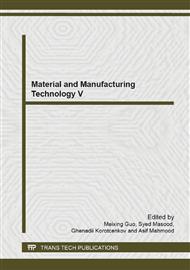p.121
p.126
p.132
p.136
p.141
p.147
p.152
p.157
p.162
Compressive Properties of Solid and Porous Parts Made from High Strength Steel Alloys by Direct Metal Deposition
Abstract:
The potential of laser assisted Direct Metal Deposition (DMD) process, for creating structures from high strength steel alloys that can be used in engineering applications requiring high strength and greater ductility in combination with high hardness is investigated. Due to increasing interest in metallic honeycomb and sandwiched structures, solid and porous specimens are prepared and examined in similar conditions. Specimen using two different powders of 316L stainless steel and H13 tool steel alloy are generated by DMD cladding on mild steel plates as substrates. The parts are tested under quasi static compressive loading and curves plotted and analysed for stress vs. strain behaviour. The results indicate that at low laser power, solid and porous steel structures with yield strength and ductility comparable to commercial grades can be produced. Porous structures show excellent characteristics suitable for applications in newly developing field of metallic honeycombs and sandwiched structures. Low modulus of elasticity is a matter of concern, but it can be improved by heat treatment.
Info:
Periodical:
Pages:
141-146
Citation:
Online since:
June 2014
Authors:
Price:
Сopyright:
© 2014 Trans Tech Publications Ltd. All Rights Reserved
Share:
Citation:


